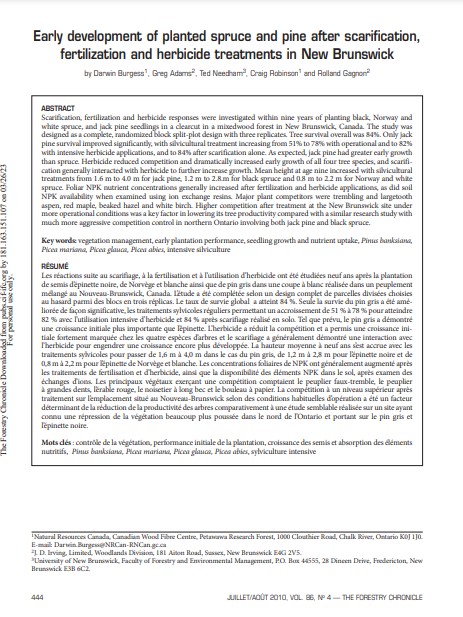Early development of planted spruce and pine after scarification, fertilization and herbicide treatments in New Brunswick
Bosque Modelo:
Fundy
Temática:
Gestión forestal
Tipo de documento:
Artículo científico
Resumen
Scarification, fertilization and herbicide responses were investigated within nine years of planting black, Norway and white spruce, and jack pine seedlings in a clearcut in a mixedwood forest in New Brunswick, Canada. The study was designed as a complete, randomized block split-plot design with three replicates. Tree survival overall was 84%. Only jack pine survival improved significantly, with silvicultural treatment increasing from 51% to 78% with operational and to 82% with intensive herbicide applications, and to 84% after scarification alone. As expected, jack pine had greater early growth than spruce. Herbicide reduced competition and dramatically increased early growth of all four tree species, and scarification generally interacted with herbicide to further increase growth. Mean height at age nine increased with silvicultural treatments from 1.6 m to 4.0 m for jack pine, 1.2 m to 2.8.m for black spruce and 0.8 m to 2.2 m for Norway and white spruce. Foliar NPK nutrient concentrations generally increased after fertilization and herbicide applications, as did soil NPK availability when examined using ion exchange resins. Major plant competitors were trembling and largetooth aspen, red maple, beaked hazel and white birch. Higher competition after treatment at the New Brunswick site under more operational conditions was a key factor in lowering its tree productivity compared with a similar research study with much more aggressive competition control in northern Ontario involving both jack pine and black spruce.
Información Bibliográfica
Autor:
Burgess, D., Adams, G., Needham, T., Robinson, C., & Gagnon, R.
Revista:
Forestry Chronicle
Año:
2010
N°:
4
País :
Canadá
Páginas:
444 - 454
Volumen:
86
Idioma:
Ingles
Palabras claves
vegetation management, early plantation performance, seedling growth and nutrient uptake, Pinus banksiana, Picea mariana, Picea glauca, Picea abies, intensive silviculture





